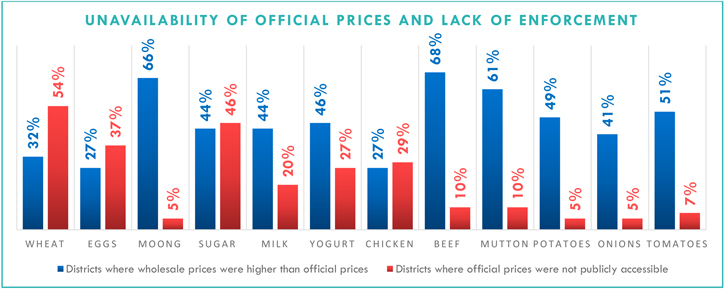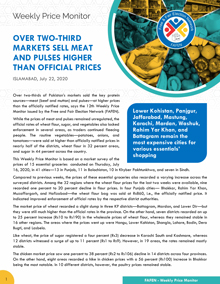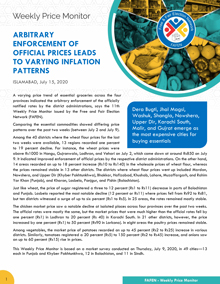- Lower Kohistan, Panjgur, Jaffarabad, Mastung, Karachi, Mardan, Washuk, Rahim Yar Khan, and Battagram remain the most expensive cities for various essentials’ shopping
ISLAMABAD, July 22, 2020: Over two-thirds of Pakistan’s markets sold the key protein sources—meat (beef and mutton) and pulses—at higher prices than the officially notified rates, says the 12th Weekly Price Monitor issued by the Free and Fair Election Network (FAFEN).
While the prices of meat and pulses remained unregulated, the official rates of wheat flour, sugar, and vegetables also lacked enforcement in several areas, as traders continued fleecing people. The routine vegetables—potatoes, onions, and tomatoes—were sold at higher than officially notified prices in nearly half of the districts, wheat flour in 32 percent areas, and sugar in 44 percent across the country.
This Weekly Price Monitor is based on a market survey of the prices of 15 essential groceries conducted on Thursday, July 16, 2020, in 41 cities—13 in Punjab, 11 in Balochistan, 10 in Khyber Pakhtunkhwa, and seven in Sindh.
Compared to previous weeks, the prices of these essential groceries also recorded a varying increase across the surveyed districts. Among the 32 regions where the wheat flour prices for the last two weeks were available, nine recorded one percent to 20 percent decline in flour prices. In four Punjab cities— Bhakkar, Rahim Yar Khan, Muzaffargarh, and Hafizabad—the wheat flour bag was sold at Rs860, i.e., the officially notified price. It indicated improved enforcement of official rates by the respective district authorities.
The market price of wheat recorded a slight slump in three KP districts—Battagram, Mardan, and Lower Dir—but they were still much higher than the official rates in the province. On the other hand, seven districts recorded an up to 25 percent increase (Rs10 to Rs190) in the wholesale prices of wheat flour, whereas they remained stable in 16 other regions. The areas where the prices went up were Hangu, Lower Kohistan, Shangla, Lahore, Badin, Dera Bugti, and Lasbela.
Like wheat, the price of sugar registered a four percent (Rs3) decrease in Karachi South and Kashmore, whereas 12 districts witnessed a surge of up to 11 percent (Rs1 to Rs9). However, in 19 areas, the rates remained mostly stable.
The chicken market price saw one percent to 38 percent (Rs2 to Rs106) decline in 14 districts across four provinces. On the other hand, eight areas recorded a hike in chicken prices with a 56 percent (Rs100) increase in Bhakkar being the most notable. In 10 different districts, however, the poultry prices remained stable.
Among vegetables, the market price of potatoes and onions recorded an up to 60 percent (Rs5 to Rs30) increase in various districts. Tomatoes also saw a similar trend in most regions except Karachi East and Upper Dir, where its market price went up by 600 percent and 200 percent since the preceding week.
The officially notified price lists of wheat flour and sugar were unavailable in various parts of the country during the reporting week. The official prices of 20-kilogram wheat flour bags were unavailable in around 54 percent of the surveyed cities. It was most notable in Khyber Pakhtunkhwa and Sindh, where 90 percent and 86 percent of the surveyed markets did not publicly display the lists. Similarly, the wheat prices were missing in 45 percent of Balochistan’s observed markets and 15 percent in Punjab.
The official sugar prices were missing in 46 percent districts—100 percent in KP, 36 percent in Balochistan, 31 percent in Punjab, and 14 percent in Sindh. Similarly, the chicken prices were not obtainable in 29 percent districts overall—64 percent in Balochistan, 57 percent in Sindh, and 10 percent in Khyber Pakhtunkhwa. However, the chicken’s official prices were displayed almost all across Punjab.
The official rates of four pulses—moong, masoor, mash, and chana—were not available in five percent to 15 percent of the surveyed markets. The prices of pulses were missing mostly in Balochistan. At the same time, milk and yogurt rates were not publicly obtainable in 20 percent and 27 percent districts, respectively.
Moreover, mutton and beef prices were missing in 10 percent of the districts, mostly in Khyber Pakhtunkhwa. The official price lists of regular vegetables—potatoes, onions, and tomatoes—were found inaccessible in around 18 percent of the Balochistan markets while elsewhere they were publicly accessible.

The lax enforcement of official prices burdened the ordinary citizens as traders sold several commodities at higher rates than the officially notified prices.
Among the routine commodities, the implementation of official prices was the weakest when it came to vegetables, pulses, and meat. Daal masoor was overpriced in 61 percent of the surveyed districts, moong (66 percent), chana (63 percent), and mash (59 percent) of the areas. These four pulses went Rs138 to Rs195 above the official price. The highest difference in wholesale prices and the official rates was in Karachi South, which was amongst the most expensive cities to shop for most pulses. Majority markets in all provinces sold pulses at higher rates than those officially notified. Khyber Pakhtunkhwa was most notable in weak enforcement of pulses’ official rates, where up to 100 percent markets charged people more than the official prices for four pulses.
Among the everyday vegetables, tomatoes, onions, and potatoes were overpriced in 51 percent, 41 percent, and 49 percent districts, respectively. The price of tomatoes went Rs70 higher than the notified rate in Jhal Magsi, while potatoes and onions were sold Rs30 and Rs20 above the announced prices in Jhal Magsi.
In the meat category, beef and mutton (average quality with bone) were overpriced in 68 percent and 61 percent of the surveyed districts, and chicken in 27 percent of areas. Mutton, beef, and chicken were sold at Rs929, Rs369, and Rs100, respectively, above the official rates. The highest difference in the market and official mutton and beef prices was in Karachi South, and of chicken in Panjgur. Traders sold wheat flour and refined sugar above the official rates in 32 percent and 44 percent districts. A 20-kilogram bag of wheat flour was priced Rs300 above the official rate in Washuk, and refined sugar Rs20 more than the market price in Mianwali. Wheat price enforcement was the weakest in Punjab and Balochistan, where 46 percent and 45 percent markets sold it above the officially notified rates. Similarly, around 86 percent of markets in Sindh sold sugar above the official prices.
The market rates of eggs per dozen were above the officially notified prices in 27 percent districts. At the same time, the rates of milk and yogurt were higher than the official ones in 44 percent and 46 percent of the surveyed areas.

TDEA-FAFEN generates the Weekly Price Monitor covering 15 essential kitchen items, including groceries such as wheat, pulses, oil, sugar, and perishable commodities like meat, and vegetables. It does this considering the need for an independent and regular assessment of the availability of such items.
The observers obtain the official prices from the officials of district administrations, or market committees, and collect the wholesale prices through market surveys. In Punjab’s case, the government price app Qeemat Punjab is also used to get the official rates.
To download the complete report, click here



